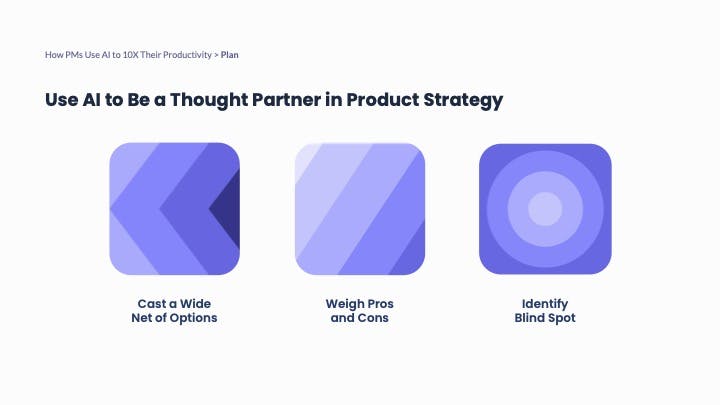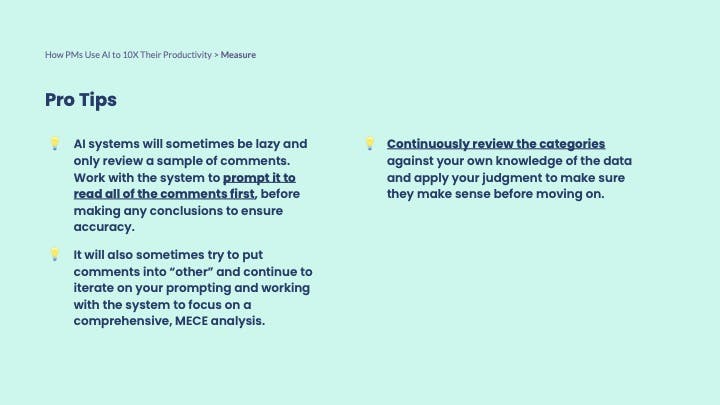Updated: April 25, 2024 - 10 min read
Welcome to a deep dive into the transformative potential of AI in product management. In this extensive guide, we'll explore how AI can revolutionize the way product managers work, from strategy formulation to day-to-day operations. Whether you're a seasoned product management professional or an aspiring PM looking to harness the power of AI, this article will equip you with actionable insights and practical tips to enhance your productivity and decision-making process.
Editorial note: This post is based on the webinar How PMs Use AI to 10X Their Productivity by Product School’s Executive in Residence, Samantha Stevens. Stevens co-founded Catalist AI after serving as a product leader at Google, Tinder, and American Express. This post contains additional insights and examples from the Product School team. You can watch the webinar in full below:
Leveraging AI for Strategic Decision-Making
Product management is inherently strategic, requiring product teams to make critical decisions that shape the direction and success of their products. With the advent of AI solutions, product managers now have powerful tools at their disposal to augment their decision-making process.

Using AI to generate new ideas
One of the fundamental challenges in product management is generating innovative ideas that resonate with users and align with business objectives. AI can be a game-changer in this aspect, serving as a virtual brainstorming partner to generate a wide range of ideas. Here's how you can effectively leverage AI to cast a wide net:
Brainstorm: Utilize AI-powered language models like ChatGPT to generate a diverse range of ideas based on your product strategy or decision-making criteria. Provide specific guidance and examples to steer the AI in the right direction and stimulate creative ideation.
Compare to your lived experience: As AI generates ideas, exercise your expertise and market knowledge to evaluate their feasibility and alignment with your product strategy. Use your judgment to identify high-quality ideas worth pursuing further.
Iterate and refine: Working with AI is an iterative process. Continuously refine your prompts and feedback based on previous interactions to hone in on targeted ideas that align with your objectives.
Find the spark: While AI may generate numerous ideas, focus on identifying sparks of inspiration that resonate with your vision. Quality trumps quantity, so prioritize ideas that have the potential to drive meaningful impact.
Creating pro and con lists with AI
Once you have a pool of ideas, the next step is to evaluate their pros and cons to make informed decisions. AI can assist in this process by analyzing data and providing insights from multiple perspectives. Here's how you can leverage AI to weigh pros and cons effectively:
Provide all relevant data: Input all pertinent data and insights into AI tools to provide context for decision-making. Upload files, and integrate your AI tools with data warehouses, CRMs, data streams, e-commerce platforms, or anywhere else pertinent data is available. AI tools equipped with computer vision algorithms can analyze visual data.
Brainstorm and compare: Task AI with listing all possible courses of action based on the provided information. Compare AI-generated options with your existing considerations to uncover potential blind spots or overlooked alternatives.
Request pros and cons: Create structured frameworks to compare the pros and cons of each option. Ask AI to analyze the implications and potential outcomes to facilitate decision-making.
Use your best judgment: Combine AI-generated insights with your expertise to make well-informed decisions. Review the list of options and refine your choices based on strategic alignment and feasibility.
Identifying blind spots with AI to mitigate risk
In product management, identifying potential blind spots and risks is crucial for mitigating uncertainties and ensuring the success of your product initiatives. AI can play a pivotal role in uncovering hidden risks and providing proactive solutions. Here's how you can harness AI to identify blind spots effectively:
Predictive analytics: Leverage AI-powered predictive analytics models to forecast potential risks and challenges based on historical data and market trends. Identify patterns and anomalies that may indicate areas of concern and take preemptive measures to address them.
Scenario planning: Use AI to simulate various scenarios and assess their impact on your product roadmap and business objectives. Explore best-case, worst-case, and realistic scenarios to develop robust contingency plans and mitigate potential risks.
Real-Time Monitoring: Implement AI-driven monitoring systems to continuously track key performance indicators (KPIs) and detect deviations from expected outcomes. Set up automated alerts to notify you of any significant changes or anomalies that require immediate attention.
Cross-Functional Collaboration: Foster cross-functional collaboration by integrating AI-driven risk assessment tools into your team's workflow. Encourage open communication and knowledge sharing to identify and address potential blind spots from different perspectives collectively.
By leveraging AI for strategic decision-making, product managers can gain valuable insights, mitigate risks, and make informed decisions that drive the success of their product initiatives.
Ready to level up in AI?
Future-proof your career with the Artificial Intelligence for Product Certification.
Learn moreOptimize Your Day
In addition to strategic decision-making, AI can significantly enhance product development and optimization processes, enabling product managers to deliver innovative solutions that meet user needs and exceed expectations. Let's explore key areas where AI can make a difference.
Streamlining processes with AI
Traditional product development cycles can be time-consuming and resource-intensive, often leading to delays and inefficiencies. AI-powered tools and automation techniques can help streamline development processes and accelerate time-to-market. Here's how you can leverage AI to accelerate development cycles:
Automated task management: Use AI-powered project management tools to automate repetitive tasks and streamline workflow processes. Delegate routine tasks such as scheduling meetings, tracking progress, and managing documentation to AI assistants, allowing your team to focus on high-impact activities.
Predictive modeling: Employ AI-driven predictive modeling techniques to forecast development timelines, resource requirements, and potential bottlenecks. Anticipate project risks and allocate resources more efficiently to minimize delays and maximize productivity.
Continuous integration and testing: Implement AI-powered integration and testing pipelines to ensure the quality and stability of your product throughout the development lifecycle. Automate code reviews, testing, and deployment processes to identify and address issues early on, reducing the likelihood of the need for manual intervention and minimizing time-to-market.
Personal productivity prompts
Try these prompts developed by Samantha Stevens for task prioritization
Prompt #1
“I'd like you to act as a productivity coach. You excel at taking long-term goals and breaking them down into extremely specific and detailed plans to work towards on a daily or weekly basis.
You help ambitious, goal-oriented people stay on track and provide them structure and guidance to achieve everything they want to experience in life.
In a minute, I am going to give you a goal I'd like to achieve and I would like you to help me come up with a very specific action plan. This plan should include tasks I can work on daily or weekly. It should be extremely clear and concrete, and you should tell me how to do each step.
I have 3-5 hours per week to work on this goal. Given my time availability, please come up with an estimate for how long it will take me to achieve my goal and create my plan as such.
This can be a collaborative process and we will work together. Before we get started, do you have any questions about the task to help you better prepare?”
Prompt #2
“You are a time management expert who excels at creating optimal plans for people’s workdays. In a minute, I am going to share my to-do list with you for today, and I would like you to make a schedule to optimize my productivity. Please use the below information and parameters as you create the schedule.”
My energy levels throughout the day tend to be:My focus and creativity levels throughout the day tend to be:The hours when I’ll be in meetings are:The meetings I need time to prepare for are:I’d like to start and end my day at:I typically take breaks at:I typically need to send [X] emails/messages in a day, and it generally takes me [X] hours.I have the following deadlines for tasks:The goals or outcomes I’m optimizing for this week/month/quarter to keep in mind are:
My to-do list for today includes:
Task 1: Time Estimate Task 2: Time Estimate
Measure User Feedback
Delivering a seamless and personalized user experience is paramount for the success of any product. AI-driven techniques can help product managers optimize user experiences by analyzing user behavior, preferences, and feedback. Here are some ways AI can enhance user experience:
Prepare your data
1. Organize data in a spreadsheet: Start by organizing your data in a spreadsheet format, with each row representing a single data point or observation and each column representing a variable or attribute. This structured format makes it easier to manage and analyze your data efficiently.
2. Ensure data quality: Before proceeding, check the quality of your data to ensure accuracy, completeness, and consistency. This may involve identifying and correcting errors, missing values, or duplicates, as well as validating data against predefined criteria or business rules.
3. Filter or translate language: If your data contains text in multiple languages, consider filtering or translating it to a common language for analysis. This step helps ensure consistency and eliminates language barriers that may affect the accuracy of your analysis or machine learning models.
4. Remove spam & irregular entries: Scan your data for spam, irrelevant, or irregular entries that may skew your analysis or introduce bias. This could include removing irrelevant records, outliers, or noise from your dataset to improve the reliability and relevance of your insights.
5. Label columns clearly: Clearly label each column in your spreadsheet with descriptive names that accurately represent the type of data it contains. This labeling practice helps users understand the meaning and purpose of each variable, facilitating easier interpretation and analysis.
6. Download as CSV: Once you've prepared and organized your data in the spreadsheet, download it in CSV (Comma-Separated Values) format. CSV is a common file format for tabular data that is easy to import into different environments.
Prompt to Identify Categories
“I would like you to act as an expert data analyst and user researcher.
You are great at analyzing data, drawing insights, and deriving trends from user-generated comments within social media platforms. Your writing is empathetic and conveys emotion.
Your audience is members of a product development team including engineers, designers, product managers, and marketers.
I would like you to help me understand the themes of YouTube comments. I am going to upload a spreadsheet that contains many rows of comments and I would like you to do a few things:
First, I would like you to identify the categories that these comments fall under (some examples include: sharing negative feedback about the video, thanking the creator for the video, sharing an idea or request for another video).
Then, I would like you to read through each item to create the categories, not just a sample of them. Then I would like you to include 5-10 example rows for each theme so that I can verify they’ve been correctly identified.”

3. Sort Comments into Categories
“I would like you to sort each row into one category. Each row can have only one category. If the row does not clearly fit into a category with a high degree of confidence, please mark it as uncategorized.
Here are some examples of correctly categorized comments:
[comment 1] : [category A] [comment 2] : [category B]
Please generate a spreadsheet with your results. Additionally, please prepare a pie chart showing the percent distribution of each category."
And that’s it!
If you apply these ideas consistently, you'll have more time time to:
Work on long-term strategic initiatives
Spend time deep thinking
Immerse yourself more in your users and market research and develop relationships with your colleagues
Updated: April 25, 2024